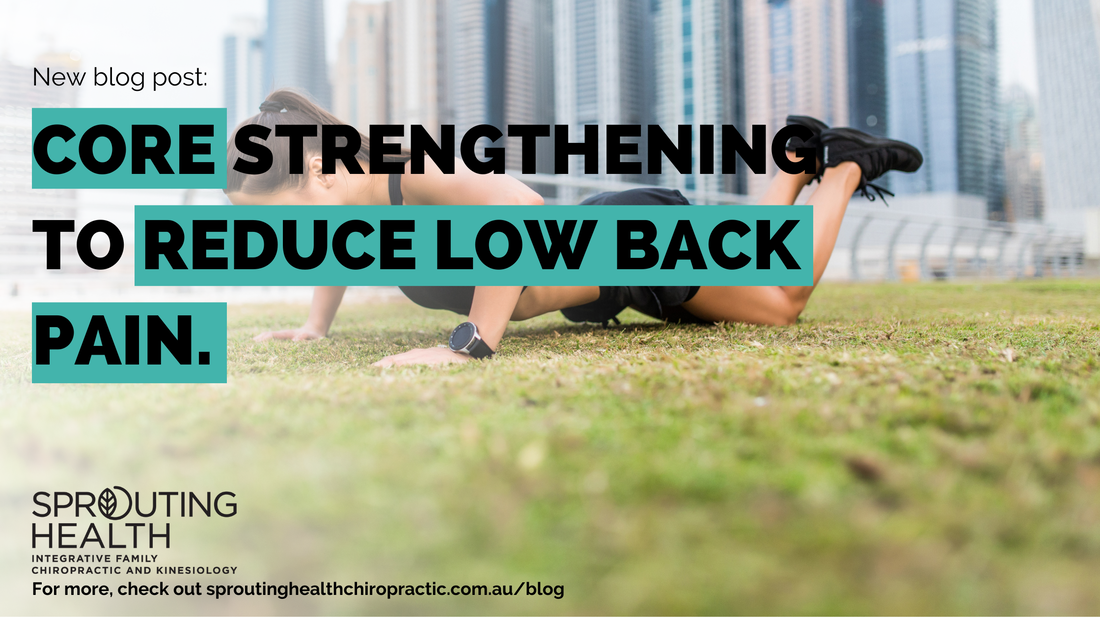|
Core strengthening to reduce low back pain.
Low back pain is a common concern prevalent in up to 80% of the population at some time in their lifetime (1). Low back pain is a multifaceted condition that develops in response to several risk factors including occupational duties (ie desk work, manual labour etc), age, gender, postural habits, behavioural and environmental factors (smoking, obesity, sedentary lifestyles) and psychological factors (stress, anxiety, depression etc) (1). While there are many causes of low back pain, a key factor that mechanically contributes to the pain, is weakness and deactivation of the core muscles. The core muscles include the abdominals, obliques and lower back musculature, these muscles provide support for the vertebrae and when inactive can create spinal instability. This leaves the body more prone to injury, pain, and discomfort. By activating your core muscles through prescribed exercises, you can build strength to the muscles surrounding your spine and assist in alleviating low back pain (1). In a study published in the Journal of Back and Musculoskeletal Rehabilitation in 2020, it was established that a combination of core activation exercises with manual therapy was an effective treatment protocol in reducing low back pain in patients with lumbar disc herniations. The study concluded that patients who received the combination of exercises with manual therapies had significantly improved functional abilities and reduced pain scores than with manual therapies alone (2). Improving core stability provides therapeutic benefits for patients experiencing chronic low back pain notably more than rest or minimal activity strategies. Book in to see one of our experienced Chiropractors to see if chiropractic care including core stabilisation exercises are right for you. 1.Frizziero, A.; Pellizzon, G.; Vittadini, F.; Bigliardi, D.; Costantino, C. Efficacy of Core Stability in Non-Specific Chronic Low Back Pain. J. Funct. Morphol. Kinesiol. 2021, 6, 37. https://doi.org/10.3390/ jfmk6020037 2. Kim YJ, Kim YH, Lee JS, Lee DJ. Effects of core stabilisation exercises combined with manual therapy on the functional disability, pain intensity, and active trigger points in patients with low back pain caused by lumbar disc herniation. J Back Musculoskelet Rehabil. 2020;33(2):177-183. Doi: 10.3233/BMR-181309
1 Comment
Most of us know vitamin D is vital for strong and healthy bones, helping with calcium absorption in the intestine. However, scientists have found other interesting association between low vitamin D blood serum level and some health conditions,that may even have an impact to your children!
Vitamin D supports a healthy immune system, reduces inflammation and helps with calcium absorption. Gathering information from different research studies, low vitamin D level is a risk factor for osteoporosis, rickets disease in children and osteomalacia in adults, bone fractures in elderly, cancer, depression, intentional self harm and suicide attempt. (1, 2) Furthermore, vitamin D deficiency has been suggested to favor a poorer outcome of Coronavirus disease-19 (COVID-19).(3) A study from Italy published in 2021 found people admitted to hospital with moderate to severe respiratory symptoms had lower vitamin D in their blood serum compared to people who only have mild symptoms.(3) Healthy Bones Australia recommends a vitamin D level of at least 50 nmol/L at the end of winter and during summer higher levels are common in the range of 60-70 nmol/L. We can get vitamin D from diet, or through UVB in direct sunlight when skin is exposed. To reach a recommended level of vitamin D, we need an average of 6-8 mins of sunlight daily(in NSW) during summer months and 5 times longer in winter months!(4) It should be noted that glasses blocks out UVB from the sunlight, together with the increase time spent indoor during winter months, vitamin D level can really fluctuate from season to season. In this case, consider consuming cod liver oil, more mushrooms, oily fishes such as salmon and mackerel to ensure vitamin D level is adequate. If you want to know more about how to keep your immune system strong and healthy this winter, talk to one of our chiropractors and see how we may be able to help manage your concerns! Reference 1. Holick MF. Vitamin D deficiency. New England journal of medicine. 2007;357(3):266-81. 2. Kjærgaard M, Waterloo K, Wang CEA, Almås B, Figenschau Y, Hutchinson MS, et al. Effect of vitamin D supplement on depression scores in people with low levels of serum 25-hydroxyvitamin D: nested case—control study and randomised clinical trial. The British Journal of Psychiatry. 2012;201(5):360-8. 3. Campi I, Gennari L, Merlotti D, Mingiano C, Frosali A, Giovanelli L, et al. Vitamin D and COVID-19 severity and related mortality: a prospective study in Italy. BMC Infectious Diseases. 2021;21(1):566. 4. Nowson CA, McGrath JJ, Ebeling PR, Haikerwal A, Daly RM, Sanders KM, et al. Vitamin D and health in adults in Australia and New Zealand: a position statement. Medical journal of Australia. 2012;196(11):686-7. Many practice members have enquired about the audible sound when a chiropractor performs an adjustment. In our previous blog, we spoke about the mechanism of how the sound or cavitation was being produced. Moving forward leaves us with the question “is the cavitation essential for an adjustment to be deemed as effective and therapeutic?” We may have an answer for this common misconception.
It is important to note the chiropractic adjustment has an impact on our nervous system.(1) Although more research needs to be done to have a better understanding of the physiological mechanism, there are biomechanical markers we can measure pre and post adjustment, ensuring adjustment is successful. Most chiropractors utilise neurological testing as their objective outcome measures.(2) These including fine touch sensitivity (pain), manual muscle strength and deep tendon reflex testing.(2) Research suggests that the sound of an audible release does not necessarily indicate that the appropriate reflexes are stimulated.(3) It suggests the greatest therapeutic benefit of the cavitation (sound) may not be physiological in nature but rather psychological.(3) The cavitation could have a powerful placebo effect on both the patient and practitioner.(3) Some people expect to hear a “cracking” sound from their treatment and interpret this sound as a sign of a successful adjustment. When the expectation is not fulfilled, it could place a negative effect on the clinical outcome. At Sprouting Health, we perform a thorough examination for each practice member and a reassessment within a certain time frame. This is to make sure we are measuring health and results objectively rather than heavily focusing on joint cavitation. We focus on very gentle means to help you reach your health goals. If you are interested in how chiropractic may benefit you, feel free to have a chat with our friendly staff members anytime. Reference 1. Wirth B, Gassner A, De Bruin ED, Axén I, Swanenburg J, Humphreys BK, et al. Neurophysiological effects of high velocity and low amplitude spinal manipulation in symptomatic and asymptomatic humans: a systematic literature review. Spine. 2019;44(15):E914-E26. 2. Hinton PM, Randall McLeod D, Broker B, MacLellan CE. Outcome measures and their everyday use in chiropractic practice. The Journal of the Canadian Chiropractic Association. 2010;54(2):118. 3. Bakker M, Miller J. Does an audible release improve the outcome of a chiropractic adjustment? The Journal of the Canadian Chiropractic Association. 2004;48(3):237. |
AuthorBlogs by the team at Sprouting Health Archives
July 2024
Categories |




 RSS Feed
RSS Feed
